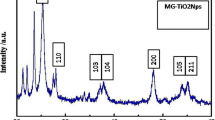Abstract
Peptide Brevinin-2R (B2R) has derived from frog skin secretions and possesses cytotoxic effects on cancer cells. Beside, cerium oxide nanoparticle (CNP) has antioxidant properties and could be used in anticancer studies. The purpose of this study is to investigate antioxidant and cytotoxicity of cerium oxide nanoparticle conjugated with B2R. First, cerium oxide nanoparticles were amine functionalized and peptide attached to it through establishment of peptide bond. Then, (1,1-diphenyl-2-picrylhydrazyl) DPPH and 2, 2′-azinobis (3-ethylbenzothiazoline-6-sulphonic acid) diammonium salt (ABTS) radical scavenging activities of CNP-B2R were determined. MTT assay were used in order to compare cytotoxicity of CNP- B2R on two different cell lines. HFLF-pI5 cell and A549 cell lines were selected as representative of normal and cancer cells, respectively. Also, the cytotoxic effects of CNP, B2R and CNP-B2R were investigated on A549 cell line. Results of antioxidant evaluations showed that the antioxidant activity of CNP-Peptide increased at higher concentration of CNP-B2R with IC50 of 0.2 and 0.54 (mg/mL) for DPPH and ABTS assays, respectively. The results of cytotoxicity effects showed that CNP-B2R was more potent in killing tumor cell line in comparison with normal cell line. Cytotoxicity of CNP, B2R and CNP-B2R demonstrated that CNP-B2R and B2R had the lower cell viability effects compared to CNP. Our findings showed cytotoxicity of CNP-B2R against cancer cell lines in comparison with normal cells indicating the potential anticancer properties of CNP-B2R.





Similar content being viewed by others
References
Akhlaghi SP et al (2015) Synthesis of amine functionalized cellulose nanocrystals: optimization and characterization. Carbohydr Res 409:48–55
Bartczak D, Kanaras AG (2011) Preparation of peptide-functionalized gold nanoparticles using one pot EDC/Sulfo-NHS coupling. Langmuir 27:10119–10123
Calderon LA, Soares AM, Stábeli RG (2012) Anuran antimicrobial peptides: an alternative for the development of nanotechnological based therapies for multi-drug-resistant infections. Signpost Open J Biochem Biotech 1:1–11
Celardo I, Pedersen JZ, Traversa E, Ghibelli L (2011) Pharmacological potential of cerium oxide nanoparticles. Nanoscale 3:1411–1420
Chigurupati S et al (2013) Effects of cerium oxide nanoparticles on the growth of keratinocytes, fibroblasts and vascular endothelial cells in cutaneous wound healing. Biomaterials 34:2194–2201
Cimini A et al (2012) Antibody-conjugated PEGylated cerium oxide nanoparticles for specific targeting of Abeta aggregates modulate neuronal survival pathways. Acta Biomater 8:2056–2067
Darroudi M, Sarani M, Kazemi Oskuee R, Khorsand Zak A, Hosseini HA, Gholami L (2014) Green synthesis and evaluation of metabolic activity of starch mediated nanoceria. Ceram Int 40:2041–2045
Das M, Patil S, Bhargava N, Kang JF, Riedel LM, Seal S, Hickman JJ (2007) Auto-catalytic ceria nanoparticles offer neuroprotection to adult rat spinal cord neurons. Biomaterials 28:1918–1925
Ghavami S et al (2008) Brevinin-2R(1) semi-selectively kills cancer cells by a distinct mechanism, which involves the lysosomal-mitochondrial death pathway. J Cell Mol Med 12:1005–1022
Giri S et al (2013) Nanoceria: a rare-earth nanoparticle as a novel anti-angiogenic therapeutic agent in ovarian cancer. PLoS One 8:e54578
Hemraz UD, Boluk Y, Sunasee R (2013) Amine-decorated nanocrystalline cellulose surfaces: synthesis, characterization, and surface properties. Can J Chemistry 91:974–981
Homayouni-Tabrizi M, Asoodeh A, Abbaszadegan M-R, Shahrokhabadi K, Nakhaie Moghaddam M (2015) An identified antioxidant peptide obtained from ostrich (Struthio camelus) egg white protein hydrolysate shows wound healing properties. Pharm Biol 53:1155–1162
Jin SE, Jin HE, Hong SS (2014) Targeted delivery system of nanobiomaterials in anticancer therapy: from cells to clinics. Biomed Res Int 2014:814208
Karakoti A, Singh S, Dowding JM, Seal S, Self WT (2010) Redox-active radical scavenging nanomaterials. Chem Soc Rev 39:4422–4432
Klotman ME, Chang TL (2006) Defensins in innate antiviral immunity. Nat Rev Immunol 6:447–456
Kriechbaum M, List M, Himmelsbach M, Redhammer GJ, Monkowius U (2014) Peptide coupling between amino acids and the carboxylic acid of a functionalized chlorido-gold(I)-phosphane. Inorg Chem 53:10602–10610
Mehrnejad F, Naderi-Manesh H, Ranjbar B, Maroufi B, Asoodeh A, Doustdar F (2008) PCR-based gene synthesis, molecular cloning, high level expression, purification, and characterization of novel antimicrobial peptide, brevinin-2R, in Escherichia coli. Appl Biochem Biotechnol 149:109–118
Patil S, Reshetnikov S, Haldar MK, Seal S, Mallik S (2007) Surface-derivatized nanoceria with human carbonic anhydrase ii inhibitors and fluorophores: a potential drug delivery device. J Phys Chem C 111:8437–8442
Patra HK, Dasgupta AK (2012) Cancer cell response to nanoparticles: criticality and optimality. Nanomed Nanotechnol 8:842–852
Puertas S et al (2011) Taking advantage of unspecific interactions to produce highly active magnetic nanoparticle-antibody conjugates. ACS Nano 5:4521–4528
Rzigalinski BA, Meehan K, Davis RM, Xu Y, Miles WC, Cohen CA (2006) Radical nanomedicine. Nanomedicine 1:399–412
Sinha R, Kim GJ, Nie S, Shin DM (2006) Nanotechnology in cancer therapeutics: bioconjugated nanoparticles for drug delivery. Mol Cancer Ther 5:1909–1917
VanCompernolle SE et al (2005) Antimicrobial peptides from amphibian skin potently inhibit human immunodeficiency virus infection and transfer of virus from dendritic cells to T cells. J Virol 79:11598–11606
Wason MS, Zhao J (2013) Cerium oxide nanoparticles: potential applications for cancer and other diseases. Am J of Rrans Res 5:126–131
Wiesner J, Vilcinskas A (2010) Antimicrobial peptides: the ancient arm of the human immune system. Virulence 1:440–464
Zhang L, Jiang H, Selke M, Wang X (2014) Selective cytotoxicity effect of cerium oxide nanoparticles under UV irradiation. J Biomed Nanotechnol 10:278–286
Acknowledgments
This work was supported by Mashhad Branch, Islamic Azad University, Mashhad, Iran, (Grant No. 92428.304.73). The authors are also grateful to Ferdowsi University of Mashhad, Mashhad, Iran, and Mashhad University of medical Sciences, Mashhad, Iran.
Author information
Authors and Affiliations
Corresponding author
Ethics declarations
Conflict of interest
Masoud Homayouni-Tabrizi, Ahmad Asoodeh, Mohammad Mashreghi, Mahere Rezazade Bazaz, Reza Kazemi Oskuee, and Majid Darroudi declare that they have no conflict of interest.
Human and Animal Rights and Informed Consent
This article does not contain any studies with human or animal subjects performed by any of the authors.
Rights and permissions
About this article
Cite this article
Homayouni-Tabrizi, M., Asoodeh, A., Mashreghi, M. et al. Attachment of a Frog Skin-Derived Peptide to Functionalized Cerium Oxide Nanoparticles. Int J Pept Res Ther 22, 505–510 (2016). https://doi.org/10.1007/s10989-016-9531-y
Accepted:
Published:
Issue Date:
DOI: https://doi.org/10.1007/s10989-016-9531-y




